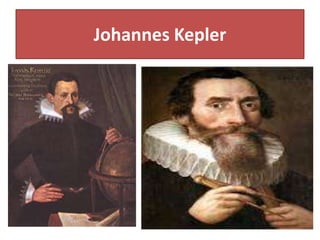
Presentation1
- 2. • Born: (1571-12-27)December 27, 1571 • Died : November 15, 1630(1630-11-15) (aged 58) • Residence: Germany • Nationality: German • Fields: Astronomy, astrology, mathematics and natural philosophy . Institutions: University of Linz • Known for: Kepler's laws of planetary motion Kepler conjecture
- 3. • Johannes Kepler was a German mathematician, astronomer and astrologer. A key figure in the 17th century scientific revolution, he is best known for his eponymous laws of planetary motion, codified by later astronomers, based on his works Astronomia nova, Harmonices Mundi, and Epitome of Copernican Astronomy. These works also provided one of the foundations for Isaac Newton's theory of universal gravitation. • During his career, Kepler was a mathematics teacher at a seminary school in Graz, Austria, where he became an associate of Prince Hans Ulrich von Eggenberg. Later he became an assistant to astronomer Tycho Brahe, and eventually the imperial mathematician to Emperor Rudolf II and his two successors Matthias and Ferdinand II. He was also a mathematics teacher in Linz, Austria, and an adviser to General Wallenstein. Additionally, he did fundamental work in the field of optics, invented an improved version of the refracting telescope (the Keplerian Telescope), and mentioned the telescopic discoveries of his contemporary Galileo Galilei.
- 4. • Kepler lived in an era when there was no clear distinction between astronomy and astrology, but there was a strong division between astronomy (a branch of mathematics within the liberal arts) and physics (a branch of natural philosophy). Kepler also incorporated religious arguments and reasoning into his work, motivated by the religious conviction and belief that God had created the world according to an intelligible plan that is accessible through the natural light of reason. Kepler described his new astronomy as "celestial physics", as "an excursion into Aristotle's Metaphysics", and as "a supplement to Aristotle's On the Heavens", transforming the ancient tradition of physical cosmology by treating astronomy as part of a universal mathematical physics.
- 5. Kepler’s law of motion In astronomy, Kepler's laws of planetary motion are three scientific laws describing orbital motion, each giving a description of the motion of planets around the Sun.
- 6. Kepler's laws are: • The orbit of every planet is an ellipse with the Sun at one of the two foci. • A line joining a planet and the Sun sweeps out equal areas during equal intervals of time. • The square of the orbital period of a planet is directly proportional to the cube of the semi-major axis of its orbit.
- 7. LAW OF ORBITS All planets move in elliptical orbits, with the sun at one focus.
- 8. This is one of Kepler's laws. The elliptical shape of the orbit is a result of the inverse square force of gravity. The eccentricity of the ellipse is greatly exaggerated here.
- 9. Orbit Eccentricity The eccentricity of an ellipse can be defined as the ratio of the distance between the foci to the major axis of the ellipse. The eccentricity is zero for a circle. Of the planetary orbits, only Pluto has a large eccentricity.
- 10. The Law of Areas A line that connects a planet to the sun sweeps out equal areas in equal times.
- 11. This is one of Kepler's laws.This empirical law discovered by Kepler arises from conservation of angular momentum. When the planet is closer to the sun, it moves faster, sweeping through a longer path in a given time.
- 12. The Law of Periods The square of the period of any planet is proportional to the cube of the axis of its orbit.
- 14. This is one of Kepler's laws.This law arises from the law of gravitation. Newton first formulated the law of gravitation from Kepler's 3rd law.
- 15. Kepler's Law of Periods in the above form is an approximation that serves well for the orbits of the planets because the Sun's mass is so dominant. But more precisely the law should be written
- 16. In this more rigorous form it is useful for calculation of the orbital period of moons or other binary orbits like those of binary stars.
- 17. DONE BY- NIKHIL SAI-9TH B - 32 OMKAR-9TH B -33 KV.NO.1.UPPAL